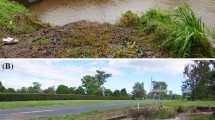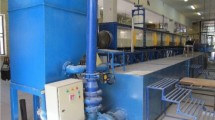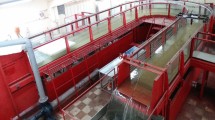Abstract
This chapter deals with the fish guidance structures (FGS) with wide bar spacing and focuses on Curved-Bar Rack-Bypass Systems (CBR-BS) (Beck 2020) for fish protection and fish guidance at water intakes. In: Boes RM (ed) VAW-Mitteilung, vol 257. VAW, ETH Zurich, Switzerland. https://vaw.ethz.ch/en/the-institute/publications/vaw-communications/2010-2019.html, Beck et al., J Hydraul Res 58:807–818, 2020a; Beck et al., J Hydraul Res 58:819–830, 2020b; Beck et al., Water 12:3244, 2020c). FGS with wider bar spacing are classified as mechanical behavioural barriers and designed for use mainly at run-of-river hydropower plants (HPPs) and water intakes with large design discharges. In the following, different types of the FGS with wide bar spacing are introduced and, fish guidance performance and design recommendations of CBR-BS are presented.
You have full access to this open access chapter, Download chapter PDF
Similar content being viewed by others
8.1 Introduction
Horizontally or vertically inclined FGS with narrow bar spacing of sb = 10–30 mm described in Chap. 7 are not recommended for medium- to large-scale HPPs with a design discharge Qd > 100 m3/s because of their velocity limitations to avoid fish impingement (Ebel 2016) and relatively high clogging risk by floating debris and hence operational problems. For these HPPs, mechanical behavioural FGS with wide bar spacing of sb = 25–100 mm present a promising alternative (Albayrak et al. 2018, 2020). They guide fish to a bypass with hydrodynamic cues created by the vertical bars instead of physically blocking fish from entering the water intake. When approaching the FGS, fish should perceive high turbulence zones and spatial velocity and pressure gradients around and between the bars and avoid passing the FGS. The velocity component parallel to the FGS guides fish towards the bypass located at the downstream end of the FGS. Louvers belong to this type of FGS with straight vertical bars placed normal to the approach flow, i.e., with a bar angle of β = 90°, and a rack angle to the approach flow of α = 10–45° (Amaral 2003, Bates and Vinsonhaler 1957, EPRI and DML 2001, Fig. 8.1a). They are widely used to bypass anadromous fish around HPPs and water intakes in the northeast USA and Canada. Furthermore, classical angled bar racks are also used for fish guidance similar to louvers, but their bars are placed at 90° to the rack axis, so that β varies with the rack angle α, i.e., β = 90° − α (Fig. 8.1b). Upon the design of louvers, Albayrak et al. (2018, 2020) developed a Modified angled Bar Rack (MBR) with β independent of α, preferably β = 45° instead of 90°. Such a reduction of the bar angle reduces the head loss and improves the rack downstream flow field (Fig. 8.1c). Albayrak et al. (2020) reported the flow fields and fish guidance efficiencies (FGEs) of a louver with α = 15° and sb = 50 mm and MBR configurations with α = 15° and 30°, sb = 50 mm and with and without bottom overlays for barbel (Barbus barbus), spirlin (Alburnoides bipunctatus), European grayling (Thymallus thymallus), European eel (Anguilla anguilla) and brown trout (Salmo trutta). The results show that MBR with α = 15° with and without overlay successfully guided 90% and 80% of the tested fish species, respectively. Furthermore, MBR with α = 30° with an overlay guided 95% of the tested fish. Such high FGEs and improved flow field of MBR led to the development of an innovative Curved-Bar Rack-Bypass System (CBR-BS) for a safe downstream fish passage at small- to large-scale HPPs and water intakes (Beck 2020; Beck et al. 2020a, b, c, Figs. 8.1 and 8.2).
8.2 Curved-Bar Rack-Bypass System
A CBR consists of vertical curved bars instead of straight bars used in louvers and MBR. They are arranged with equidistant spacing along the rack axis and mounted in a rack frame. The rack is placed across an intake canal at a rack angle typically α = 15–30° (Fig. 8.2a, b). A curved-bar is designed to have a bar angle to the flow direction ranging from β = 45–90° at the upstream bar tip and an outflow angle of δ = 0°, i.e. parallel to the flow direction in the power canal at the downstream end of the bar (Fig. 8.2d). The clear spacing between the bars is sb ≥ 25 mm, the bar thickness t = 10 mm, and the bar depth d = 100 mm. The upstream and downstream bar tips are typically rounded to avoid fish injuries.
A CBR creates hydrodynamic cues of turbulence, high velocity and pressure gradients by its bars similar to the working principle of louvers and MBR (Albayrak et al. 2020; Beck et al. 2020c). Such flow structures in front and between the bars are perceived and avoided by fish approaching the rack. Thanks to the angled rack arrangement, the velocity component parallel to the rack, Vp, guides the fish towards the bypass system (BS) without causing a shock from a major physical contact at the rack. A CBR acts as behavioural barrier for smaller fish while it functions as a physical barrier for fish whose width is larger than the bar spacing (Fig. 8.2b). For an effective guidance of the CBR, the ratio between Vp and the rack normal velocity Vn should be above 1 along the rack, i.e. Vn < Vp (Courret and Larinier 2008). Furthermore, to ensure that fish can swim actively along the CBR without exhaustion, the rack normal velocity should be smaller than the sustained swimming speed of fish, i.e. Vn < Vsustained. A general value of Vsustained = 0.50 m/s is recommended for smolts and silver eels (Raynal et al. 2013) as a first proxy.
Laboratory tests by Beck et al. (2020c) confirm the behavioural guiding effect of the CBR for several fish species except the European eel. They reported that above 75% of spirlin, barbel, nase (Chondrostoma nasus) and Atlantic salmon parr (Salmo salar) and below 75% of brown trout and eel were efficiently guided by a hydraulically optimized CBR configuration with sb = 50 mm, α = 30° to a full depth BS in the laboratory tests. The use of bottom and top overlays may improve the FGE of the CBR-BS for bottom and surface-oriented fish species, respectively. The effectiveness of such overlays was demonstrated and recommended by EPRI and DML (2001) and Amaral (2003) for louvers and by Albayrak et al. (2020) for MBR. Furthermore, overlays can mitigate operational problems of driftwood, organic fine material and sediment by guiding them to the bypass (Beck 2020).
The curved-bars of a CBR cause a flow straightening effect, which results in ~20 and ~5 folds lower head losses compared to the same Louver and MBR configurations and in quasi-symmetrical downstream flow (Beck et al. 2020b), improving the rack downstream flow field and possibly HPP turbine efficiency. A head loss prediction equation for louvers, MBR and CBR is presented in Beck et al. (2020a).
Successful CBR design requires a good bypass system design, which should attract, safely collect and transport the fish and return them unharmed to the river downstream of a HPP. Full depth, surface, bottom and both surface and bottom bypasses are the main types and should be selected based on the biomechanical requirements of the target fish species and HPP layout. The ratio of the bypass entrance flow velocity to the approach flow velocity VR = Uby/Uo and a gradual velocity increase along the rack to the bypass are crucial parameters for fish guidance and bypass acceptance (e.g. Simmons 2000; Albayrak et al. 2020; Beck 2020; Beck et al. 2020c). To this end, USBR (2006) recommends 1.1 ≤ VR ≤ 1.5 for louver-BS, Ebel (2016) recommends 1.0 ≤ VR ≤ 2.0 for horizontal bar rack-BS, while Beck et al. (2020c) recommend VR = 1.1 ≤ VR ≤ 1.2 for CBR-BS or other FGS to protect and guide fish of all species, life stages and sizes.
8.3 Conclusions and Outlook
Given the significantly reduced head losses and high fish guidance and protection efficiencies, CBR-BS presents a high potential over Louvers and MBRs for a safe downstream fish movement at HPPs at minimum negative economic impacts. Cost-effective engineering design recommendations for CBR-BS are given in-detail by Beck (2020). The first CBR-BS variant is currently installed, and its effectiveness will be assessed at the pilot HPP of Herrentöbeli located on River Thur in Switzerland. More projects at HPPs of different sizes and layouts are needed to evaluate the CBR-BS effectiveness under various flow conditions and for different fish species and to further improve its design.
References
Albayrak I, Kriewitz CR, Hager WH, Boes RM (2018) An experimental investigation on louvres and angled bar racks. J Hydraul Res 56(1):59–75. https://doi.org/10.1080/00221686.2017.1289265
Albayrak I, Boes RM, Kriewitz-Byun CR, Peter A, Tullis BP (2020) Fish guidance structures: new head loss formula, hydraulics and fish guidance efficiencies. J Ecohydraulics. https://doi.org/10.1080/24705357.2019.1677181
Amaral SV (2003) The use of angled bar racks and louvers for guiding fish at FERC-licensed projects. FERC fish passage workshop. Holden, USA
Bates DW, Vinsonhaler R (1957) Use of louvers for guiding fish. Trans American Fish Soc 86(1):38–57
Beck C (2020) Fish protection and fish guidance at water intakes using innovative curved-bar rack bypass systems. In: Boes RM (ed) VAW-Mitteilung, vol 257. VAW, ETH Zurich, Switzerland. https://vaw.ethz.ch/en/the-institute/publications/vaw-communications/2010-2019.html
Beck C, Albayrak I, Meister J, Boes RM (2020a) Hydraulic performance of fish guidance structures with curved bars: part 1: head loss assessment. J Hydraul Res 58(5):807–818. https://doi.org/10.1080/00221686.2019.1671515
Beck C, Albayrak I, Meister J, Boes RM (2020b) Hydraulic performance of fish guidance structures with curved bars: part 2: flow fields. J Hydraul Res 58(5):819–830. https://doi.org/10.1080/00221686.2019.1671516
Beck C, Albayrak I, Meister J, Peter A, Selz OM, Leuch C, Vetsch DF, Boes RM (2020c) Swimming behavior of downstream moving fish at innovative curved-bar rack bypass systems for fish protection at water intakes. Water 12(11):3244. https://doi.org/10.3390/w12113244
Courret D, Larinier M (2008) Guide pour la conception de prises d’eau ‘ichtyocompatibles’ pour les petites centrales hydroélectriques (Guide for the design of fish-friendly intakes for small hydropower plants). Agence de l’Environnement et de la Maîtrise de l’Energie (ADEME) (in French)
Ebel G (2016) Fischschutz und Fischabstieg an Wasserkraftanlagen – Handbuch Rechen-und Bypasssysteme. Ingenieurbiologische Grundlagen, Modellierung und Prognose, Bemessung und Gestaltung. In: Fish protection and downstream passage at hydro power stations – handbook of bar rack and bypass systems. Bioengineering principles, modelling and prediction, dimensioning and design), 2nd edn. Büro für Gewässerökologie und Fischereibiologie Dr. Ebel: Halle (Saale), Germany, 2016 (In German)
[EPRI] Electric Power Research Institute (US), [DML] Dominion Millstone Laboratories (US) (2001) Evaluation of angled bar racks and louvers for guiding fish at water intakes. Palo Alto (CA) and Waterford (CT): EPRI. Report No.: 1005193
Raynal S, Chatellier L, Courret D, Larinier M, Laurent D (2013) An experimental study on fish-friendly trashracks – part 2. Angled trashracks. J Hydraul Res 51(1):67–75
Simmons A (2000) Effectiveness of a fish bypass with an angled bar rack at passing Atlantic salmon and steelhead trout smolts at the Lower Saranac Hydroelectric Project, advances in fish passage technology. Am Fish Soc 95–102
USBR (2006) Fish protection at water diversions – a guide for planning and designing fish exclusion facilities. Technical Report. U.S. Department of the Interior, Bureau of Reclamation
Author information
Authors and Affiliations
Corresponding author
Editor information
Editors and Affiliations
Rights and permissions
Open Access This chapter is licensed under the terms of the Creative Commons Attribution 4.0 International License (http://creativecommons.org/licenses/by/4.0/), which permits use, sharing, adaptation, distribution and reproduction in any medium or format, as long as you give appropriate credit to the original author(s) and the source, provide a link to the Creative Commons license and indicate if changes were made.
The images or other third party material in this chapter are included in the chapter's Creative Commons license, unless indicated otherwise in a credit line to the material. If material is not included in the chapter's Creative Commons license and your intended use is not permitted by statutory regulation or exceeds the permitted use, you will need to obtain permission directly from the copyright holder.
Copyright information
© 2022 The Author(s)
About this chapter
Cite this chapter
Albayrak, I., Boes, R.M. (2022). Fish Guidance Structure with Wide Bar Spacing: Mechanical Behavioural Barrier. In: Rutschmann, P., et al. Novel Developments for Sustainable Hydropower. Springer, Cham. https://doi.org/10.1007/978-3-030-99138-8_8
Download citation
DOI: https://doi.org/10.1007/978-3-030-99138-8_8
Published:
Publisher Name: Springer, Cham
Print ISBN: 978-3-030-99137-1
Online ISBN: 978-3-030-99138-8
eBook Packages: EngineeringEngineering (R0)






